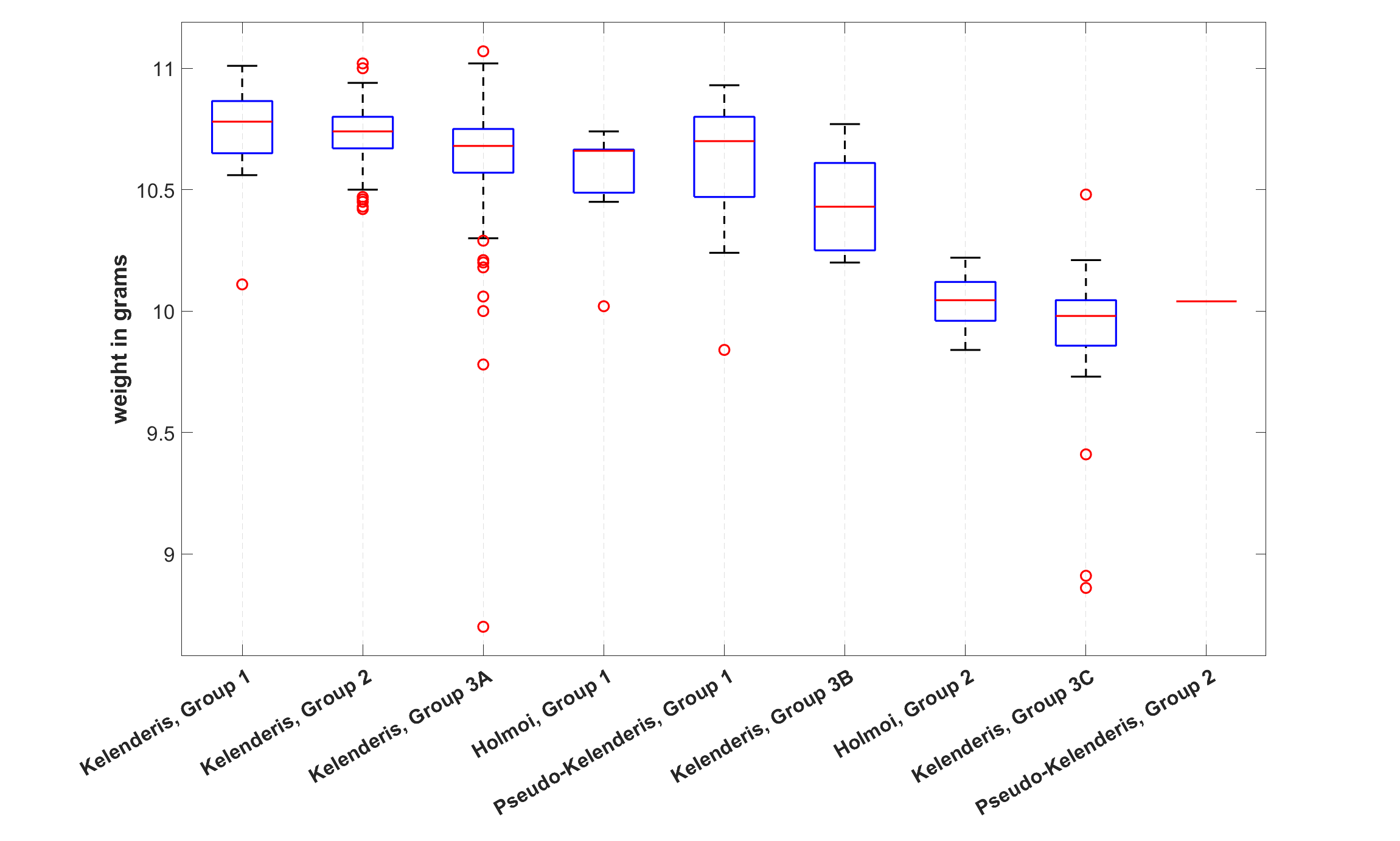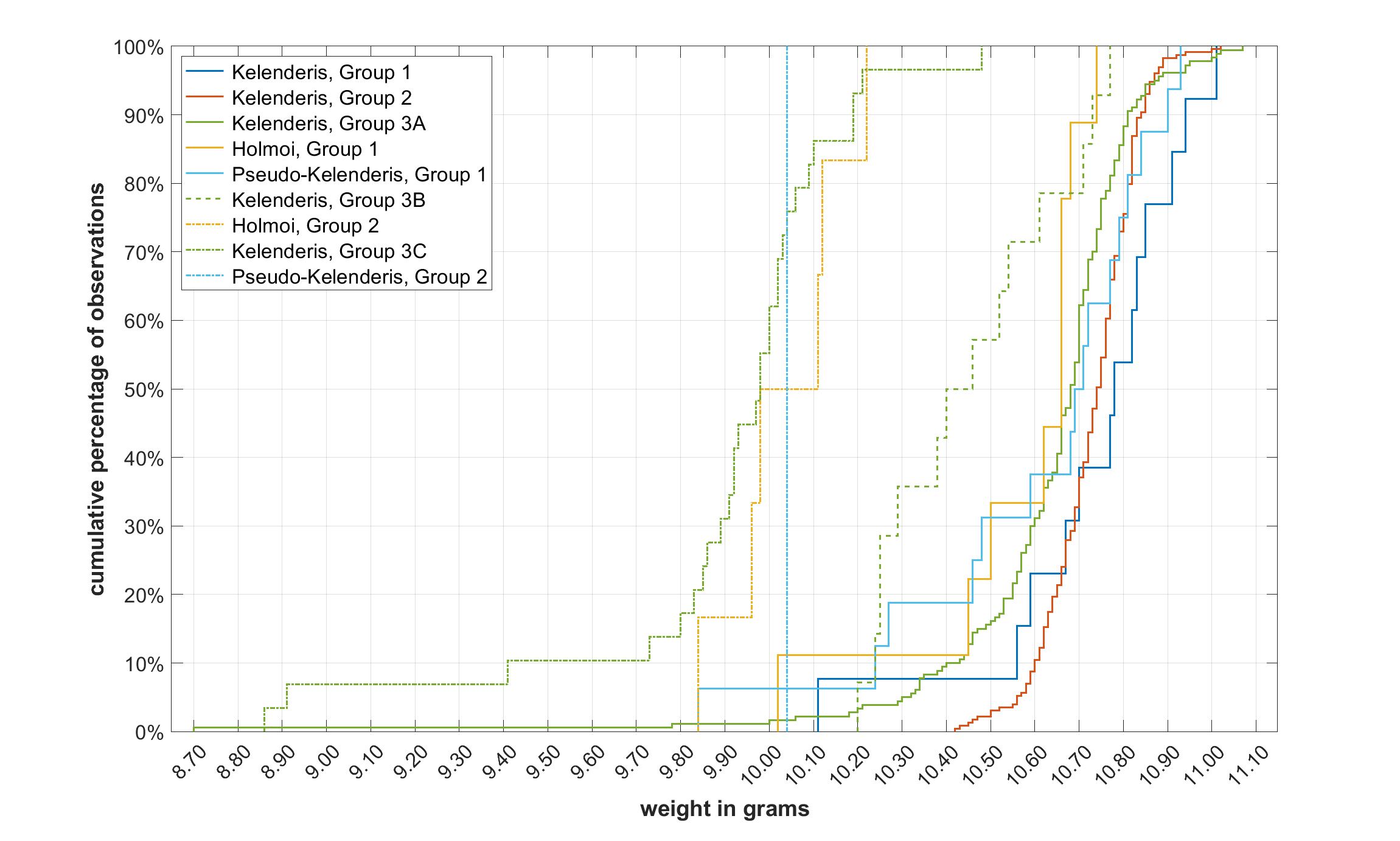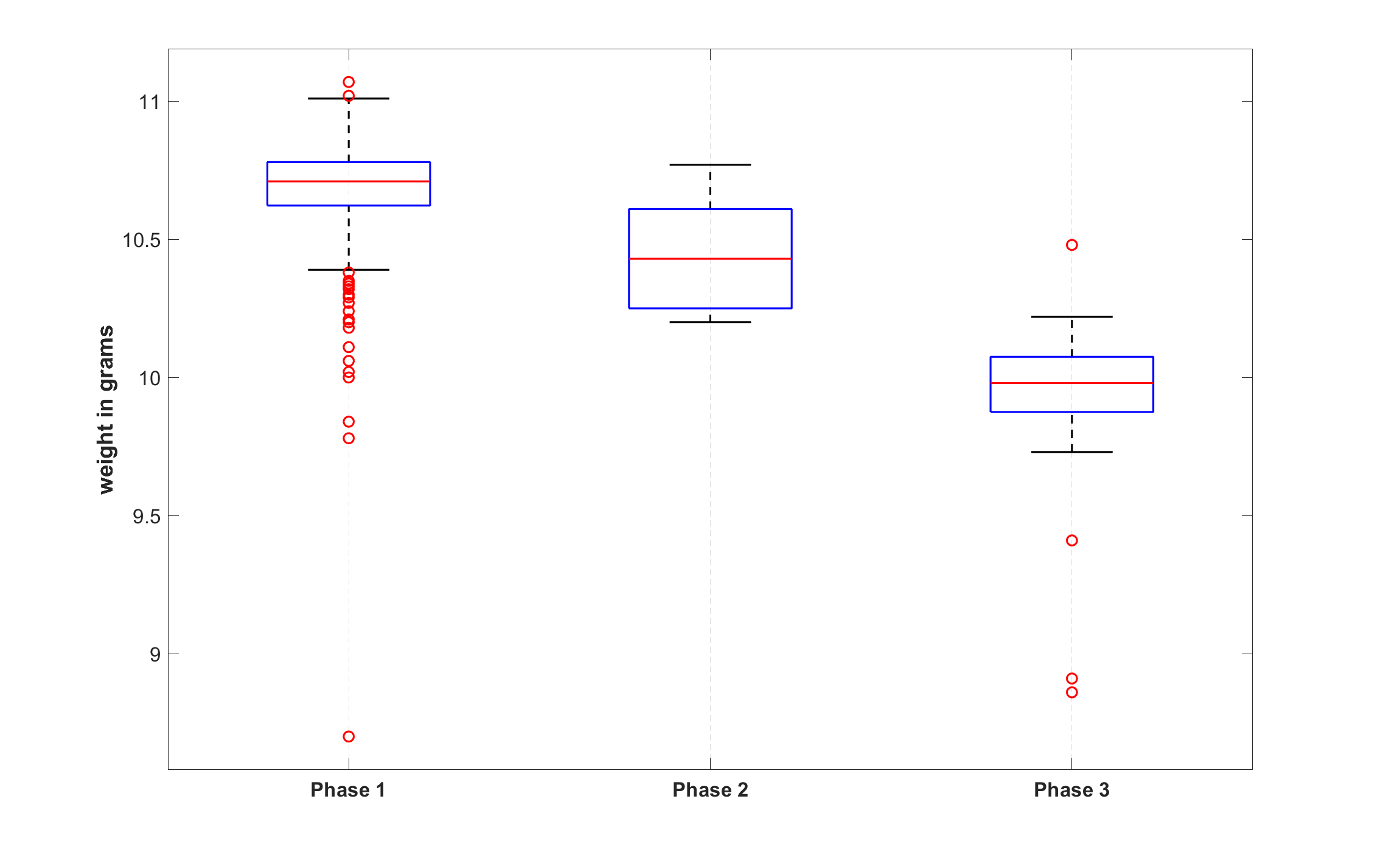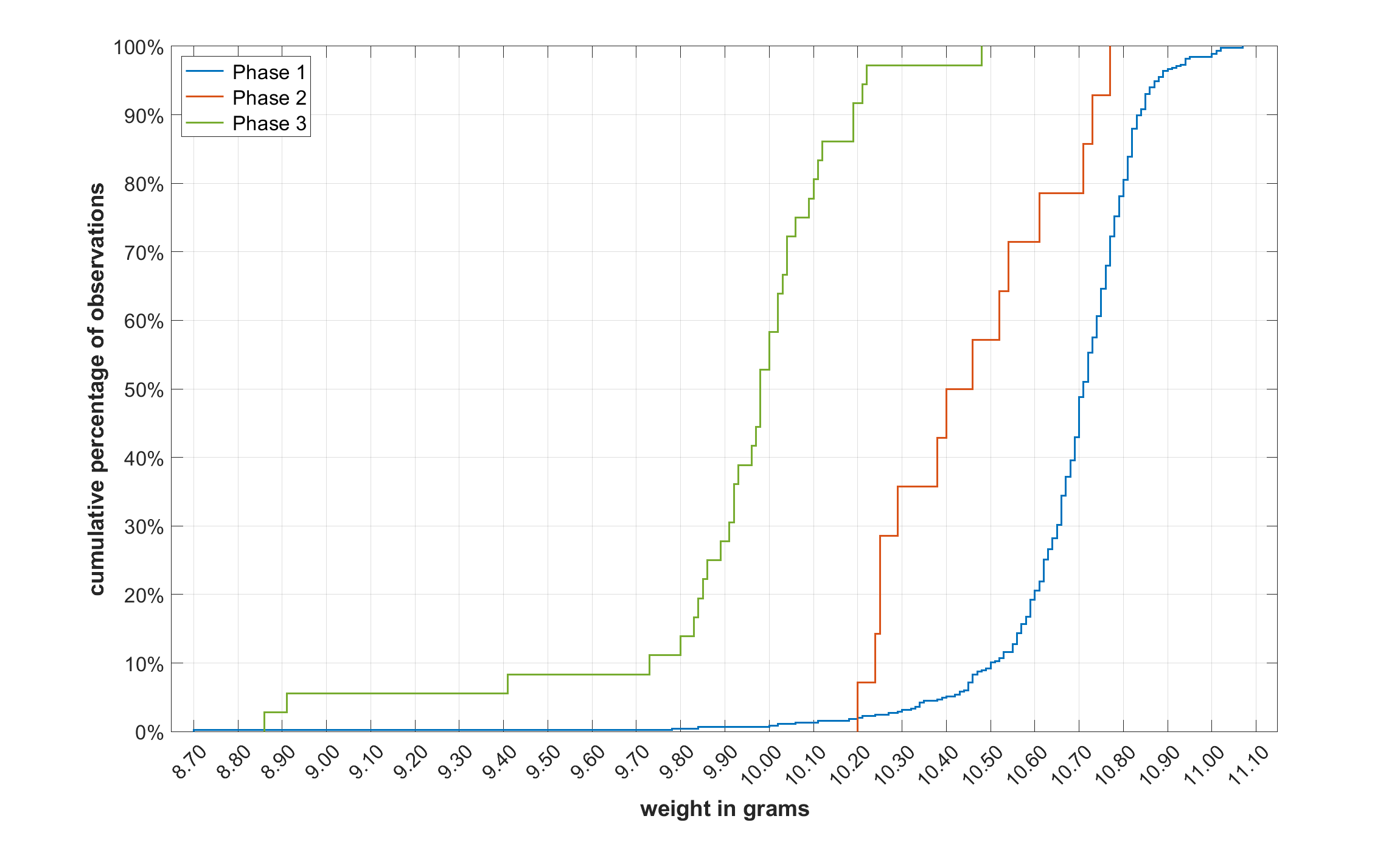| Coin catalogue sections: | Holmoi, Kelenderis, Pseudo-Kelenderis Mints |
| Coin corpus datasets: | Holmoi, Group 1, Holmoi, Group 2, Kelenderis, staters, Group 1, Kelenderis, staters, Group 2, Kelenderis, staters, Group 3, Pseudo-Kelenderis Mints |
Summary
Silver staters minted at Holmoi, Kelenderis and Pseudo-Kelenderis mints can be divided into three large groups based on their weights, which probably correspond to the three phases of the weight standard development in Cilicia Trachea. This relative chronology of stater coinage is based on the assumption that the weight standards used at these mints were synchronous in time.
Analysis
Based on the Coin Catalogue and weight analyses of Holmoi, Kelenderis and Pseudo-Kelenderis mints, silver staters can be divided into the following groups, which group together coin types with the same weight standard:
| Holmoi: | Group 1: | Type 1; |
| Group 2: | Type 2. | |
| Kelenderis: | Group 1: | Types 1.1–3; |
| Group 2: | Types 2.1–12; | |
| Group 3A: | Types 3.1–3 and 3.7–12; | |
| Group 3B: | Types 3.13–14; | |
| Group 3C: | Types 3.4–6 and 3.15–17. | |
| Pseudo-Kelenderis: | Group 1: | Type 1; |
| Group 2: | Type 2. |
Box plots1, cumulative distributions and basic descriptive statistics of these groups are presented in Figures 1–2 and Table 1 (Std. Dev. denotes the standard deviation and IQR the interquartile range), respectively.
Figure 1: Box plots of individual groups of staters
Figure 2: Cumulative distributions of individual groups of staters
| Group | Count | Mean | Median | Std. Dev. | IQR |
|---|---|---|---|---|---|
| Kelenderis, Group 1 | 13 | 10.73 | 10.78 | 0.23 | 0.21 |
| Kelenderis, Group 2 | 229 | 10.73 | 10.74 | 0.10 | 0.13 |
| Kelenderis, Group 3A | 180 | 10.64 | 10.68 | 0.23 | 0.18 |
| Holmoi, Group 1 | 9 | 10.55 | 10.66 | 0.22 | 0.18 |
| Pseudo-Kelenderis, Group 1 | 16 | 10.61 | 10.70 | 0.29 | 0.33 |
| Kelenderis, Group 3B | 14 | 10.45 | 10.43 | 0.20 | 0.36 |
| Holmoi, Group 2 | 6 | 10.04 | 10.04 | 0.14 | 0.16 |
| Kelenderis, Group 3C | 29 | 9.90 | 9.98 | 0.34 | 0.19 |
| Pseudo-Kelenderis, Group 2 | 1 | 10.04 | 10.04 | 0.00 | 0.00 |
Table 1: Basic descriptive statistics of individual groups of staters
As Figures 1–2 and Table 1 show, the staters of these mints can be divided in terms of the similarity of their weights into three large groups, which probably correspond to the three phases of the weight standard development in Cilicia Trachea:
| Phase 1: | Holmoi, Group 1; Kelenderis, Groups 1, 2 and 3A; Pseudo-Kelenderis, Group 1. |
| Phase 2: | Kelenderis, Group 3B. |
| Phase 3: | Holmoi, Group 2; Kelenderis, Group 3C; Pseudo-Kelenderis, Group 2. |
Box plots and descriptive statistics of these three assumed phases are presented in Figure 3 and Table 2, respectively. In Table 2, note the large negative skewness of Phases 1 and 3, which is manifested in Figure 3 by high numbers of outliers below the bottom whiskers. The weight distributions of these two phases are considerably left-skewed.
Figure 3: Box plots of phases of weight standard development
| Statistics | Phase 1 | Phase 2 | Phase 3 |
|---|---|---|---|
| Number of coins: | 447 | 14 | 36 |
| Mean: | 10.68 | 10.45 | 9.93 |
| Standard deviation: | 0.18 | 0.20 | 0.31 |
| Interquartile range: | 0.16 | 0.36 | 0.20 |
| Skewness: | -3.85 | 0.28 | -2.10 |
| Kurtosis: | 34.90 | 1.71 | 8.25 |
| Minimum: | 8.70 | 10.20 | 8.86 |
| 25th percentile: | 10.62 | 10.25 | 9.88 |
| Median: | 10.71 | 10.43 | 9.98 |
| 75th percentile: | 10.78 | 10.61 | 10.07 |
| Maximum: | 11.07 | 10.77 | 10.48 |
Table 2: Descriptive statistics of phases of weight standard development
Figure 4 presents relative frequency histograms. The bars represent the relative frequencies of observations ranging from 8.70 to 11.10 g in increments of 0.10 g and the continuous curves represent approximations of the data by the Weibull distribution2 based on maximum likelihood estimates. Cumulative distributions are shown in Figure 5.
Figure 4: Relative frequency histograms of phases of weight standard development
Figure 5: Cumulative distributions of phases of weight standard development
The distributions of coin weights in individual groups have different shapes and are asymmetric. Instead of comparing means, it is therefore statistically more appropriate to compare medians. Since the analyzed data have many tied values, the percentile bootstrap method was chosen. Table 3 shows the observed sample medians and bootstrap 95% confidence intervals.3 Table 4 shows the differences in sample medians, their bootstrap 95% confidence intervals and p-values.4 These results confirm that the weight distributions of Phases 1, 2 and 3 are significantly different at the 5% significance level.
| median | 95% confidence interval | ||
|---|---|---|---|
| Phase 1 | 10.71 | 10.70 | 10.72 |
| Phase 2 | 10.43 | 10.27 | 10.61 |
| Phase 3 | 9.98 | 9.92 | 10.03 |
Table 3: Medians and their confidence intervals
| medians difference | 95% confidence interval | p-value | ||
|---|---|---|---|---|
| Phase 1 vs Phase 2 | 0.28 | 0.11 | 0.45 | 0.004 |
| Phase 1 vs Phase 3 | 0.73 | 0.68 | 0.79 | <0.001 |
| Phase 2 vs Phase 3 | 0.45 | 0.27 | 0.62 | <0.001 |
Table 4: Differences in medians
1The bottom and top of each box are the 25th and 75th percentiles of the dataset, respectively (the lower and upper quartiles). Thus, the height of the box corresponds to the interquartile range (IQR). The red line inside the box indicates the median. Whiskers (the dashed lines extending above and below the box) indicate variability outside the upper and lower quartiles. From above the upper quartile, a distance of 1.5 times the IQR is measured out and a whisker is drawn up to the largest observed data point from the dataset that falls within this distance. Similarly, a distance of 1.5 times the IQR is measured out below the lower quartile and a whisker is drawn down to the lowest observed data point from the dataset that falls within this distance. Observations beyond the whisker length are marked as outliers and are represented by small red circles.
2The probability density function of the Weibull distribution is f(x;a,b) = b/a×(x/a)b-1×exp(-(x/a)b) for x≥0, and f(x;a,b) = 0 for x<0, where a>0 is the shape parameter and b>0 is the scale parameter of the distribution. The estimated values of the parameters for Phases 1, 2 and 3, respectively:
a: 10.755, 10.549, 10.049;
b: 84.239, 58.051, 46.595.
3Wilcox 2022, pp. 122–3. The number of bootstrap samples was 106 (one million) for each group.
4Wilcox 2022, pp. 196–7. The number of bootstrap samples was 106 (one million) for each comparison.
6 January 2024 – 25 February 2024




